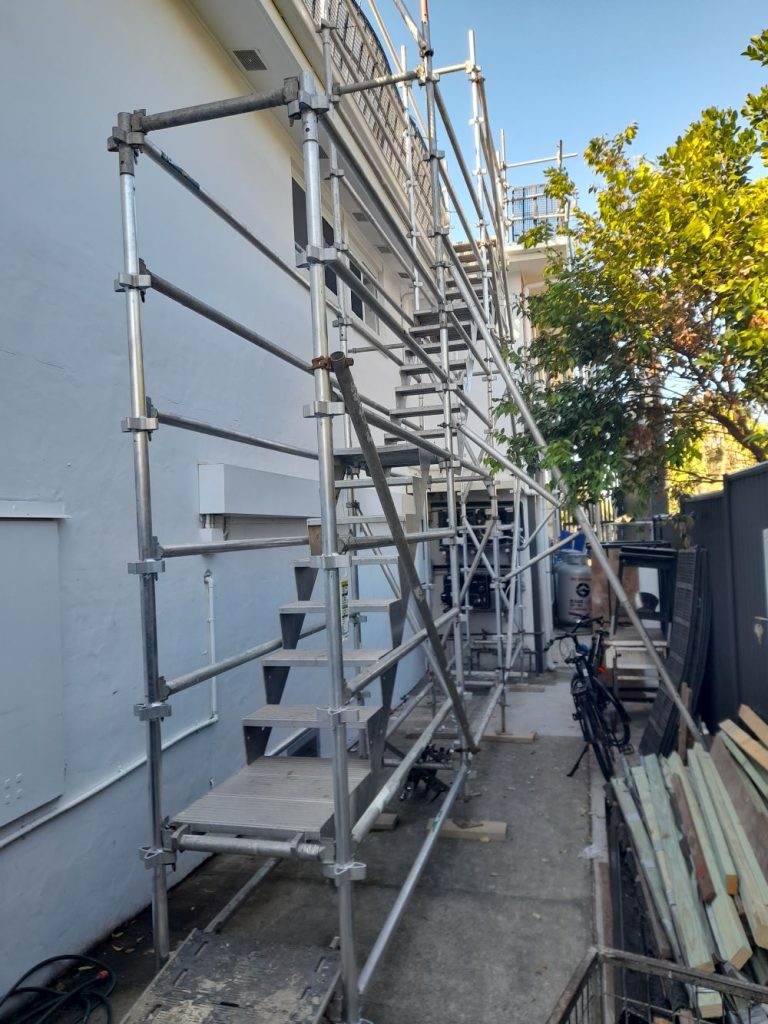If you have ever been involved in tasks that require scaffolding, you might have pondered on the practicality and safety of positioning a ladder atop it in order to access elevated spaces. Although this may appear to be a straightforward and convenient approach, several critical safety issues must be meticulously assessed prior to proceeding. Gaining a comprehensive understanding of the associated risks and regulations is paramount to ensuring the safety of yourself and all individuals within the workspace.
Despite its seemingly simple nature, the act of using a ladder on scaffolding is EXCEEDINGLY hazardous. The introduction of ANY extraneous objects onto a stable scaffolding framework can lead to significant dangers. The potential risks tied to this practice are considerable and must not be dismissed or underestimated. In any construction environment, it is crucial to prioritise safety over convenience to ensure the wellbeing of all personnel involved.
This article aims to delve into the numerous reasons why it is inadvisable to place a ladder on scaffolding, shedding light on potential hazards and discussing alternative, safer options that ought to be taken into account.

Comprehending the Safety Hazards Linked to Ladder Use on Scaffolding
The unequivocal answer is NO; using a ladder on scaffolding is NOT safe.
Employing a ladder on scaffolding introduces significant hazards that can jeopardise the safety of the entire structure. The primary purpose of scaffolding is to function as a secure and stable working platform that complies with stringent load-bearing specifications. When a ladder or any additional equipment is introduced onto this framework, it can destabilise the entire system, thereby heightening the risk of accidents, falls, and severe injuries. Consequently, while it may seem like a clever shortcut to access higher areas, the potential dangers far outweigh any perceived benefits.
Also Read: What NOT to Do When Using Scaffolding for Safety
Uncovering the Specific Dangers Associated with Ladder Use on Scaffolding
Having established that using a ladder on scaffolding is unsafe, we will now examine the specific hazards that accompany this practice:
1. Instability of the Scaffolding Structure Compromised by Ladder Use
Scaffolding is meticulously engineered as a safe and robust working platform, but the introduction of a ladder can significantly disrupt this balance. Ladders are specifically designed to be positioned on solid ground rather than atop another structure. When a ladder is placed on scaffolding, it can destabilise the entire assembly, thereby greatly increasing the likelihood of falls, slips, or even total scaffold failure. This precarious situation poses a serious risk not only to the user but also to all individuals in the vicinity.
2. Increased Fall Risk Due to Elevated Heights
When working on scaffolding, you are already positioned above ground level. Incorporating a ladder can further elevate this height, thereby amplifying the risk of falling. The instability associated with using a ladder on scaffolding can create perilous situations, particularly if the ladder shifts, slips, or fails to maintain its stability. The potential for severe injuries escalates dramatically with higher falls, rendering this practice exceedingly dangerous.
Also Read: Who Is Responsible for Scaffold Hire and Safety?
3. Incorrect Ladder Angle Heightens Accident Potential
Ladders are specifically designed to be utilised at precise angles to ensure safety during operation. Placing a ladder carelessly on top of scaffolding prevents achieving the correct angle necessary for stability. An improperly positioned ladder is prone to slipping or sliding, particularly when placed on a surface lacking solidity and support. Furthermore, scaffolding does not offer the same level of stability as a solid ground surface, making it challenging to secure the ladder at the appropriate angle, thus increasing the likelihood of accidents.
4. Insufficient Secure Attachment Presents Serious Hazards
Utilising a ladder on scaffolding often results in inadequate securing of the ladder itself. Most scaffolding setups are not designed to accommodate ladders, which means there is generally no reliable method to attach them securely. Although the ladder may initially appear stable, any movement, vibrations, or slips can swiftly lead to the ladder falling or tipping over, posing a serious risk to users and those nearby.
5. Violation of OSHA Safety Regulations Incurred by Improper Ladder Use
When operating on a construction site, adherence to safety regulations is often mandated. The Occupational Safety and Health Administration (OSHA) enforces strict guidelines regarding the safe utilisation of scaffolding and ladders. The improper use of a ladder on scaffolding can lead to violations of OSHA standards (such as 1926.1053 for ladders and 1926.451 for scaffolds). Non-compliance may result in legal repercussions, fines, penalties, or even project shutdowns, making it imperative to diligently follow safety guidelines.
6. Risks of Certification Nullification Due to Unsafe Practices
Every scaffolding installation undergoes a rigorous certification process to ensure that it has been deemed safe for use by professionals. Modifying that setup by introducing a ladder jeopardises its certification status. Should an incident occur, you may find yourself without coverage concerning work health and safety regulations. Lacking valid certification exposes you to significant risk, which is an unacceptable gamble that could have serious consequences.
Discovering Safer Alternatives for Accessing Elevated Areas
Now that we have thoroughly examined the reasons against using a ladder on scaffolding, let’s explore safer alternatives for safely achieving your desired height without compromising safety or violating regulations:
Utilise Integrated Scaffold Access Solutions for Enhanced Safety
Most scaffolding installations are equipped with integrated access features, such as ladders or stairways. These access points are specifically engineered to ensure safety while navigating up and down the scaffolding. If your scaffolding includes these built-in access options, it is essential to take full advantage of them! They are designed to work seamlessly with the scaffolding system, significantly enhancing overall security and minimising the likelihood of accidents.

Consider Work Platforms or Extensions for Safer Access to Heights
Another viable alternative is to utilise a work platform or an extension. These solutions are specifically designed to provide a stable surface for working while facilitating safe access to elevated levels. They represent a more secure option than attempting to precariously balance a ladder on scaffolding. Work platforms are robust and certified for use with scaffolding, ensuring your safety while promoting the efficient and effective completion of tasks at higher elevations.
Key Takeaways on the Use of Ladders with Scaffolding
So, can you safely position a ladder on scaffolding?
The definitive answer is no! The utilisation of a ladder on scaffolding can result in structural instability, elevated fall risks, and violations of essential safety regulations. The potential repercussions simply do not justify the associated hazards. Instead, make use of built-in scaffold access methods or opt for safer alternatives, such as work platforms. Always prioritise safety; the last thing you want is to jeopardise your wellbeing or that of others for the sake of convenience. Adhering to proper guidelines will ensure you maintain safety and compliance on the job.
The Article: Ladder Safety on Scaffolding: What You Need to Know first appeared on https://writebuff.com
The Article Ladder Safety Tips for Scaffolding You Must Know Was Found On https://limitsofstrategy.com

